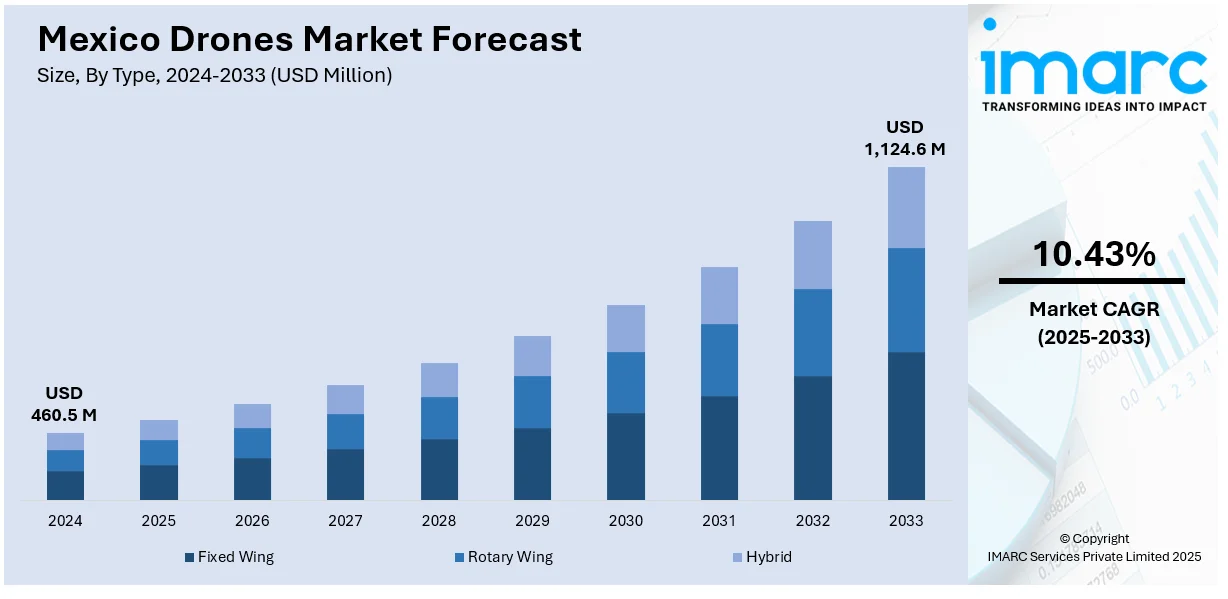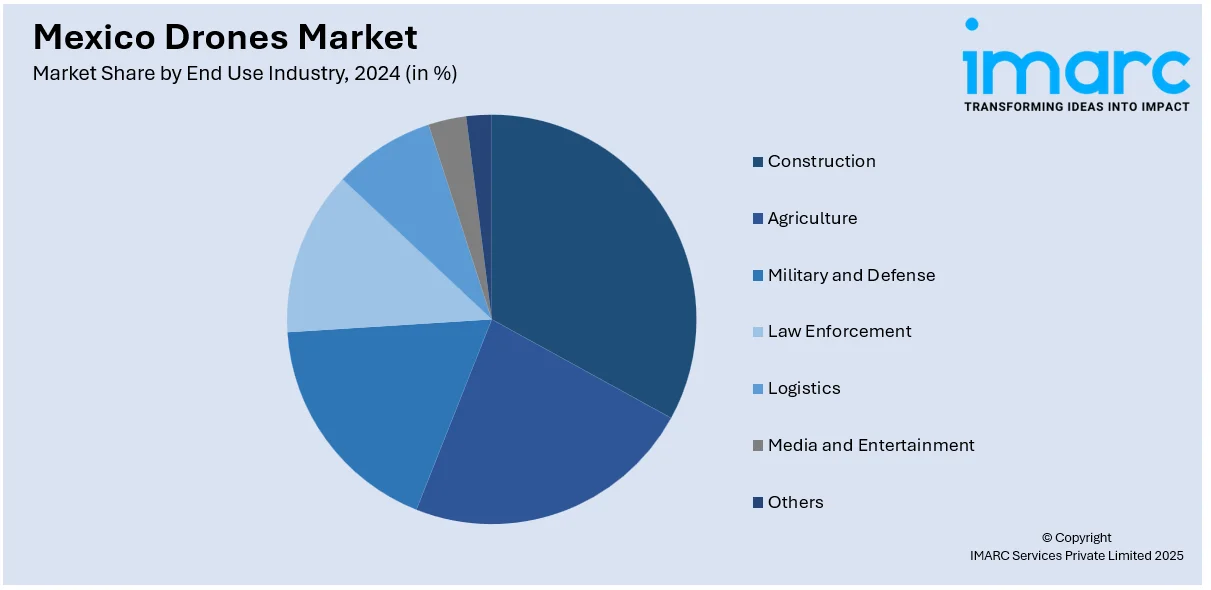
Mexico Drones Market Size, Share, Trends and Forecast by Type, Component, Payload, Point of Sale, End Use Industry, and Region, 2025-2033
Mexico Drones Market Overview:
The Mexico drones market size reached USD 460.5 Million in 2024. Looking forward, IMARC Group expects the market to reach USD 1,124.6 Million by 2033, exhibiting a growth rate (CAGR) of 10.43% during 2025-2033. The market is fueled by the rising product demand in agriculture sector for monitoring crops, technological innovation in drones and government backing for regulation. Moreover, the increasing adoption in industries such as logistics, surveillance, and infrastructure inspection, and increased interest in recreational use of drones also fuels the Mexico drones market growth.
|
Report Attribute
|
Key Statistics
|
|---|---|
|
Base Year
|
2024 |
|
Forecast Years
|
2025-2033
|
|
Historical Years
|
2019-2024
|
| Market Size in 2024 | USD 460.5 Million |
| Market Forecast in 2033 | USD 1,124.6 Million |
| Market Growth Rate 2025-2033 | 10.43% |
Mexico Drones Market Trends:
Agricultural Drone Adoption
A crucial trend for the drone industry in Mexico is increasing agricultural applications. Crop monitoring, field evaluation, and irrigation system optimization are prominent drone applications today. Drones are a more cost-effective and rapid way to manage extensive areas due to the magnitude of Mexico's agricultural land. Through real-time aerial imagery and data analysis, drones help farmers make informed decisions, optimally utilize resources, and increase their yields. This technology assists in early detection of disease or pest attacks, or water stress, allowing for targeted intervention. Drones can also assist precision farming by applying fertilizers, pesticides, and herbicides in a targeted manner to minimize cost and environmental impact. Demand for agricultural drones will continue to increase in Mexico due to innovation adoption among farmers, government grants, and private investments in drone technology.

Increased Regulation and Industry Standards
With Mexico's drone market undergoing expansion, it is becoming imperative to develop clearer regulations and industry standards. The Mexican authorities are working to create a regulatory framework to allow for the safe and efficient operation of drones in the different sectors. The Federal Civil Aviation Agency (AFAC) has established rules that will govern flight operations of drones in relation to airspace management, certification of operators, and operational limits. In addition to ensuring safety, this regulatory clarity would give confidence to industry players and consumers who invest in drone technology. As drone applications expand into commercial activities such as logistics, surveying, and infrastructure inspection, comprehensive regulations will be ever more critical. These regulations aim to provide balance between innovative developments and concerns over safety and privacy, paving the way for a structured kind of environment for industry growth. The setting up of the regulations is expected to further stimulate the adoption of drones in Mexico.
Drones in Infrastructure and Surveillance
Deployment of drones for the inspection and monitoring of infrastructure in Mexico is spreading fast. Today, drones are used to maintain the health of key infrastructure including bridges, highways, and pipes, providing an efficient and more secure alternative than conventional methods. Armed with sensors and high-resolution cameras, drones can identify leaks, wear, or structural defects without requiring workers to venture into hard-to-access locations, cutting cost and time. Drones are also being used more for security and surveillance, especially along urban areas, borders, and industrial estates. As drone technology allows real-time video streaming and bird's-eye views, monitoring is improved, and the response time is quickened. This trend is particularly applicable in Mexico, where surveillance and infrastructure upkeep are of crucial importance. With improving technology and falling costs, the use of drones for infrastructure inspection and surveillance will keep on increasing, bringing new opportunities to both public and private sectors. In November 2024, scientists at the New Mexico Tech Institute of Mining and Technology in Socorro revealed that they have dedicated the last two years to creating drones and robots using the remains of deceased birds. Currently undergoing testing, the animatronic birds could assist in researching avian formations, coloration and communication, along with various other natural ecosystems.
Mexico Drones Market Segmentation:
IMARC Group provides an analysis of the key trends in each segment of the market, along with forecasts at the regional level for 2025-2033. Our report has categorized the market based on type, component, payload, point of sale, and end use industry.
Type Insights:
- Fixed Wing
- Rotary Wing
- Hybrid
The report has provided a detailed breakup and analysis of the market based on the type. This includes fixed wing, rotary wing, and hybrid.
Component Insights:
- Hardware
- Software
- Accessories
The report has provided a detailed breakup and analysis of the market based on the component. This includes hardware, software, and accessories.
Payload Insights:
- <25 Kilograms
- 25-170 Kilograms
- >170 Kilograms
A detailed breakup and analysis of the market based on the payload have also been provided in the report. This includes <25 kilograms, 25-170 kilograms, and >170 kilograms.
Point of Sale Insights:
- Original Equipment Manufacturers (OEM)
- Aftermarket
The report has provided a detailed breakup and analysis of the market based on the point of sale. This includes original equipment manufacturers (OEM)and aftermarket.
End Use Industry Insights:

- Construction
- Agriculture
- Military and Defense
- Law Enforcement
- Logistics
- Media and Entertainment
- Others
A detailed breakup and analysis of the market based on the end use industry have also been provided in the report. This includes construction, agriculture, military and defense, law enforcement, logistics, media and entertainment, and others.
Regional Insights:
- Northern Mexico
- Central Mexico
- Southern Mexico
- Others
The report has also provided a comprehensive analysis of all the major regional markets, which include Northern Mexico, Central Mexico, Southern Mexico and others.
Competitive Landscape:
The market research report has also provided a comprehensive analysis of the competitive landscape. Competitive analysis such as market structure, key player positioning, top winning strategies, competitive dashboard, and company evaluation quadrant has been covered in the report. Also, detailed profiles of all major companies have been provided.
Mexico Drones Market Report Coverage:
| Report Features | Details |
|---|---|
| Base Year of the Analysis | 2024 |
| Historical Period | 2019-2024 |
| Forecast Period | 2025-2033 |
| Units | Million USD |
| Scope of the Report |
Exploration of Historical Trends and Market Outlook, Industry Catalysts and Challenges, Segment-Wise Historical and Future Market Assessment:
|
| Types Covered | Fixed Wing, Rotary Wing, Hybrid |
| Components Covered | Hardware, Software, Accessories |
| Payloads Covered | <25 Kilograms, 25-170 Kilograms, >170 Kilograms |
| Point of Sales Covered | Original Equipment Manufacturers (OEM), Aftermarket |
| End Use Industries Covered | Construction, Agriculture, Military and Defense, Law Enforcement, Logistics, Media and Entertainment, Others |
| Regions Covered | Northern Mexico, Central Mexico, Southern Mexico, Others |
| Customization Scope | 10% Free Customization |
| Post-Sale Analyst Support | 10-12 Weeks |
| Delivery Format | PDF and Excel through Email (We can also provide the editable version of the report in PPT/Word format on special request) |
Key Questions Answered in This Report:
- How has the Mexico drones market performed so far and how will it perform in the coming years?
- What is the breakup of the Mexico drones market on the basis of type?
- What is the breakup of the Mexico drones market on the basis of component?
- What is the breakup of the Mexico drones market on the basis of payload?
- What is the breakup of the Mexico drones market on the basis of point of sale?
- What is the breakup of the Mexico drones market on the basis of end use industry?
- What is the breakup of the Mexico drones market on the basis of region?
- What are the various stages in the value chain of the Mexico drones market?
- What are the key driving factors and challenges in the Mexico drones market?
- What is the structure of the Mexico drones market and who are the key players?
- What is the degree of competition in the Mexico drones market?
Key Benefits for Stakeholders:
- IMARC’s industry report offers a comprehensive quantitative analysis of various market segments, historical and current market trends, market forecasts, and dynamics of the Mexico drones market from 2019-2033.
- The research report provides the latest information on the market drivers, challenges, and opportunities in the Mexico drones market.
- Porter's five forces analysis assist stakeholders in assessing the impact of new entrants, competitive rivalry, supplier power, buyer power, and the threat of substitution. It helps stakeholders to analyze the level of competition within the Mexico drones industry and its attractiveness.
- Competitive landscape allows stakeholders to understand their competitive environment and provides an insight into the current positions of key players in the market.
Need more help?
- Speak to our experienced analysts for insights on the current market scenarios.
- Include additional segments and countries to customize the report as per your requirement.
- Gain an unparalleled competitive advantage in your domain by understanding how to utilize the report and positively impacting your operations and revenue.
- For further assistance, please connect with our analysts.
 Request Customization
Request Customization
 Speak to an Analyst
Speak to an Analyst
 Request Brochure
Request Brochure
 Inquire Before Buying
Inquire Before Buying




.webp)




.webp)












